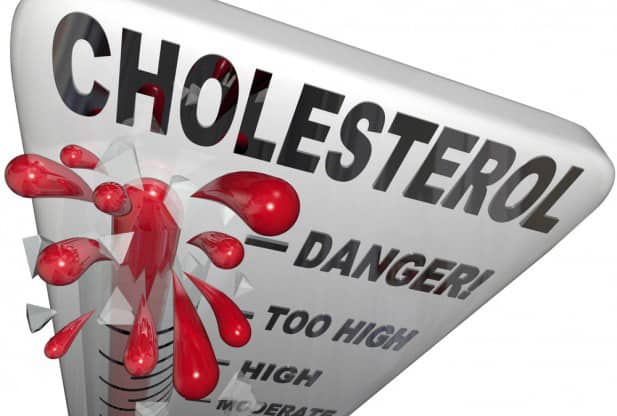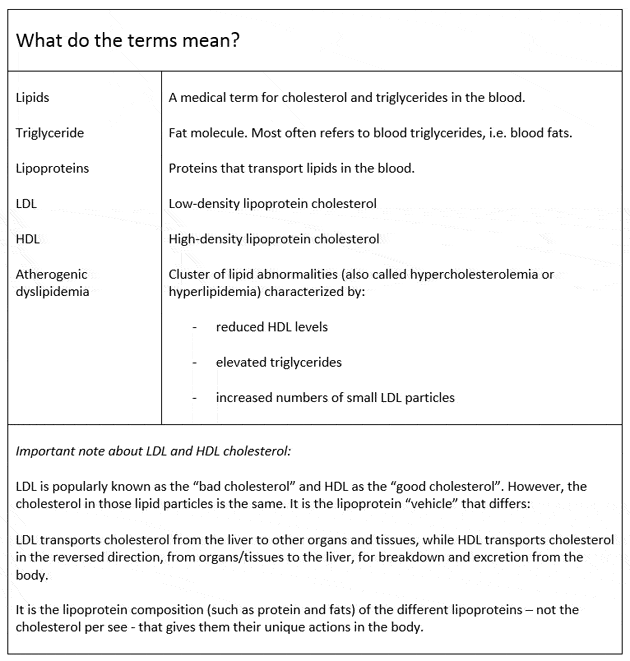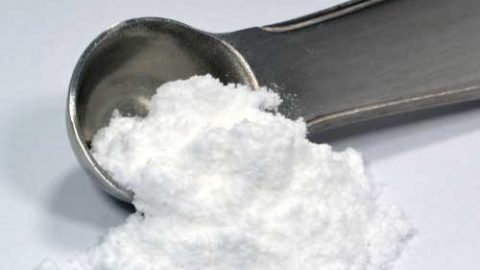In the United States, cardiovascular diseases account for about 1 of every 3 deaths.[1] The cornerstone in heart disease treatment is reducing elevations of LDL, popularly known as the “bad cholesterol” (see table below “What do the terms mean?”) [2, 3], primarily with statins, the most widely used cholesterol/ heart disease drug.[4]
However, when one looks at the aggregate effectiveness of statin treatment in all studies, morbidity and mortality rates among statin-treated patients still remain approximately two thirds to three quarters of those found in patients randomized to placebo.[5, 6] In the “Treating to New Targets” study there were still 80% cases of cardiovascular disease, despite intensive treatment with high-dose statins.[7]
Thus, many patients – even those treated aggressively with statins to meet LDL goals – have residual cardiovascular risk.[8-13] This remaining risk is associated with low levels of HDL, increased levels of triglycerides, and elevated numbers of small, dense, atherogenic LDL particles [8, 10, 11, 14-17] and other common metabolic abnormalities that you will find out about in this article…


Why your LDL – “bad cholesterol” – level does not tell the true story…
LDL is the type of cholesterol that has been getting most attention, and still is holding center stage in cardiovascular disease prevention and treatment. However, as it turns out, it is not the best predictor of heart disease outcomes…
In people hospitalized for heart disease, almost half have admission LDL levels below 100 mg/dL [18], which is considered ideal.[19] More than half of the patients have admission HDL levels below 40 mg/dL [18], which is too low. Also, most patients have elevated triglyceride levels.[18] Another study in patients with coronary artery disease found that 63% have low HDL [20], and 40% of patients who do not have any reason to take cholesterol-lowering medications, also have low HDL.[20] This clearly shows that LDL levels do not tell the whole story. In people with heart disease or acute coronary syndrome, the most common lipid abnormality is not LDL, but low levels of HDL, occurring in almost 70% of cases.[21]
It has been estimated that at least 18 million US adults with cardiovascular disease have low LDL levels below 100-130 mg/dL.[22] Most patients who develop heart disease have LDL levels in the “normal” range [23], and men with heart disease have LDL levels that are no different from those in men without heart disease.[24] These statistics clearly shows that we need to abandon the myopic focus of LDL and broaden our view of lipid-related risk factors.
Atherogenic dyslipidemia – the complete lipid profile
When people talk about cholesterol in general terms, what is being referred to is typically LDL. However, LDL is just a small and simplified part of the puzzle.
A common form of lipid abnormality is atherogenic dyslipidemia, which denotes a constellation of lipid risk factors – the “lipid triad” – with low HDL levels, elevated triglyceride levels, and increased numbers of small LDL particles. Atherogenic dyslipidemia seems to be the principal driver of atherosclerosis development.[25, 26]
Atherogenic dyslipidemia is often seen in people who have enlarged waist lines and insulin resistance, and those who are physically inactive.[2] It also commonly occurs in people with premature heart disease.[2, 27, 28] It is notable that in these metabolic disorders, LDL levels are often normal.[29] In addition it should be highlighted that LDL cholesterol is not part of neither atherogenic dyslipidemia nor the metabolic syndrome; however, both low HDL levels and increased triglyceride levels are part of the metabolic syndrome criteria.[30, 31]
HDL
It is well-documented that low HDL is an independent risk factor for cardiovascular disease risk.[32-36] Importantly, the increased cardiovascular risk associated with low HDL is greater than that associated with elevated LDL, and persists even after adjustment for other lipid parameters and cardiovascular
risk factors.[32] For each decrease in HDL of 1 mg/dL (0.026 mmol/L), the risk of coronary heart disease increases by 2% in men and by 3% in women.[35]
Men with HDL below 35 mg/dL have double the risk of death from any cause and a 4-fold increased risk of heart disease, compared to men with HDL above 54 mg/dL.[33] Women with HDL below 45 mg/dL have 1.5-fold increased risk of death from any cause and a 3-fold increased risk of heart disease, compared to women with HDL above 69 mg/dL.[33]
Notably, the prognostic significance of low HDL is similar whether or not LDL is elevated.[32, 37] The risk of coronary heart disease in a patient with elevated LDL (220 mg/dL or 5.7 mmol/L) and normal HDL (45 mg/dL or 1.2 mmol/L) is comparable with the risk in a patient with well-controlled LDL (100 mg/ dL or 2.6 mmol/L) and low HDL-cholesterol (25 mg/dL or 0.6 mmol/L).[32, 37]
Triglycerides (blood fats)
Early studies failed to convincingly establish an independent association between triglyceride levels and cardiovascular disease and mortality.[38, 39] However, recent data suggests that elevated triglyceride levels and triglyceride-rich lipoproteins contribute to causing premature atherosclerosis and coronary heart disease [13, 39-41], even in people with normal LDL levels.[42]
Compared to having triglyceride levels of 90-149 mg/dL, triglyceride levels of 150-199 mg/dL (borderline-high) and above 200 mg/dL (high) are associated with an increased risk of cardiovascular and total mortality of 9-15% and 20-25%, respectively.[43] In contrast, having low triglyceride levels of below 90 mg/dL is associated with a 6-17% reduced cardiovascular and total mortality risk.[43]
Overall, the risk of cardiovascular and all-cause death is increased by 13% and 12% for each 88 mg/dL (1 mmol/L) increase in triglyceride level.[43] This risk is present even after having taken into consideration other common risk factors, such as age, gender, blood pressure, BMI, diabetes, and smoking. Another study found a 32% and 76% increased cardiovascular disease risk in men and women, respectively, for each 88 mg/dL increase in triglyceride level, independent of HDL levels.[44]
Aside from increasing cardiovascular risk and mortality, elevated triglycerides may increase risk for cancer.[45] These findings suggest that reducing triglyceride levels may help prevent cardiovascular disease and mortality, as well as other causes of death.
Small, dense LDL particles
The LDL cholesterol level is not a good indicator of atherosclerosis and cardiovascular risk, because risk correlates more closely with the number of circulating atherogenic particles than with the quantity of cholesterol carried by those particles.[46, 47] To help understand why the number of LDL particles is more important the amount of cholesterol carried by those LDL particles, one can think of traffic jam, which is caused by the number of cars, regardless of the number of people in the cars.
There is substantial evidence that – at any given LDL level – a preponderance of small, dense LDL particles is associated with greater risk of coronary heart disease, compared to a preponderance of larger LDL particles.[48] Until recently, an independent effect of small dense LDL had not been established, in part due to concomitant elevations in triglycerides and reductions in HDL.[46, 48-50] However, a recent analysis demonstrated that in three out of four independent laboratory methodologies, the association between small, dense LDL particles and increased atherosclerosis is independent of those other lipid measurements.[51] This highlights the importance of small, dense LDL particles in cardiovascular disease development, as well as the potential risk reduction achieved by treatments that reduce the number of small, dense LDL particles.
You can find out your LDL number and size by getting an advanced lipid panel (as opposed to the standard lipid panel). For more info on that, see my previous article
“Blood Cholesterol Testing – don’t let the routine standard lipid panel fool you!”
How common is atherogenic dyslipidemia?
Over half of U.S. adults in the general population have lipid abnormalities.[52, 53] While only 28% of the general population have high LDL [53, 54], over half have high triglycerides.[55] Data from the third National Health and Nutrition Examination Survey in the USA showed that low HDL is present in 35% of men (defined as below 40 mg/dL) and 39% of women (defined as below 50 mg/dL).[2] Notably, atherogenic dyslipidemia is highly prevalent even in people with low LDL levels and in those receiving statin treatment.[55, 56] Low levels of HDL and elevated triglyceride levels are even common among patients treated for dyslipidemia.[55]
The large majority of US adults – 70% – are either overweight or obese [57], and about 40% of U.S. adults have the metabolic syndrome.[58, 59] The prevalence of insulin resistance tracks with that of the metabolic syndrome [58, 60], and is reflected in the constantly expanding waistlines of the U.S. population; over half of U.S. adults have abdominal obesity (defined as a waist circumference at or above 40 inches in men and 34 inches in women).[61-63]
The escalating prevalence of metabolic syndrome and expanded waistlines has shifted the risk profile of the population towards people in whom LDL is less predictive of cardiovascular disease, and in whom risk identification is missed by narrow-minded LDL testing and LDL focused treatment.[64]
Summary
The unacceptably high residual risk among people on intensive statin treatment clearly indicates that LDL – the “bad” cholesterol – is not the main culprit behind the greatest killer in modern times – cardiovascular disease!
As it turns out, the risk that has been attributed to LDL cholesterol is more strongly correlated to the number of LDL particles than the total amount of cholesterol transported in the LDL particles. Think of traffic jam, which is caused by the number of cars, regardless of the number of people in the cars.
Sedentary lifestyles and expanding waistlines give rise to low levels of HDL – the “good” cholesterol – and high levels of triglycerides (i.e. blood fats). This in turn is accompanied by an elevated number of small, dense, atherogenic LDL particles, and represents the most common form of lipid abnormality – atherogenic dyslipidemia.
Healthy eating and regular exercise are the best ways to prevent and treat atherogenic dyslipidemia. And some dietary supplements – especially niacin (high dose vitamin B3) and fish oil (to a lesser degree) – have greater beneficial effects on atherogenic dyslipidemia that the most widely prescribed cholesterol drug – statins! Without dangerous side-effects. I will cover the beneficial effects of niacin and fish oil on the prevention and treatment of atherogenic dyslipidemia and cardiovascular disease in upcoming articles. Stay tuned…
———————————————————————————————————————————————–
About Monica Mollica > www.Ageless.Fitness

Monica Mollica holds a Master degree in Nutrition from the University of Stockholm / Karolinska Institue, Sweden. She has also done PhD level course work at renowned Baylor University, TX.
Having lost her father in a lifestyle-induced heart attack at an age of 48, she is a strong advocate of primary prevention and early intervention, and the development of lifestyle habits for health promotion at all ages.
Today, Monica is sharing her solid medical research insights, real life hands on experience, and passion for health and fitness by offering nutrition / supplementation / exercise / health consultation services, and working as a medical writer specializing in health promotion, fitness and anti-aging.
She is currently in the process of writing a book on testosterone, covering health related issues for both men and women.
———————————————————————————————————————————————–
References:
1. Mozaffarian, D., et al., Heart disease and stroke statistics–2015 update: a report from the American Heart Association. Circulation, 2015. 131(4): p. e29-322.
2. National Cholesterol Education Program Expert Panel on Detection, E. and A. Treatment of High Blood Cholesterol in, Third Report of the National Cholesterol Education Program (NCEP) Expert Panel on Detection, Evaluation, and Treatment of High Blood Cholesterol in Adults (Adult Treatment Panel III) final report. Circulation, 2002. 106(25): p. 3143-421.
3. Brunzell, J.D., et al., Lipoprotein management in patients with cardiometabolic risk: consensus conference report from the American Diabetes Association and the American College of Cardiology Foundation. J Am Coll Cardiol, 2008. 51(15): p. 1512-24.
4. Stone, N.J., et al., 2013 ACC/AHA guideline on the treatment of blood cholesterol to reduce atherosclerotic cardiovascular risk in adults: a report of the American College of Cardiology/American Heart Association Task Force on Practice Guidelines. J Am Coll Cardiol, 2014. 63(25 Pt B): p. 2889-934.
5. LaRosa, J.C., J. He, and S. Vupputuri, Effect of statins on risk of coronary disease: a meta-analysis of randomized controlled trials. JAMA, 1999. 282(24): p. 2340-6.
6. Libby, P., The forgotten majority: unfinished business in cardiovascular risk reduction. J Am Coll Cardiol, 2005. 46(7): p. 1225-8.
7. LaRosa, J.C., et al., Intensive lipid lowering with atorvastatin in patients with stable coronary disease. N Engl J Med, 2005. 352(14): p. 1425-35.
8. Colquhoun, D., et al., Prevalence of mixed dyslipidemia among Australian patients undergoing lipid-modifying therapy. Exp Clin Cardiol, 2013. 18(1): p. e32-6.
9. Hausenloy, D.J. and D.M. Yellon, Enhancing cardiovascular disease risk reduction: raising high-density lipoprotein levels. Curr Opin Cardiol, 2009. 24(5): p. 473-82.
10. Fruchart, J.C., et al., The Residual Risk Reduction Initiative: a call to action to reduce residual vascular risk in patients with dyslipidemia. Am J Cardiol, 2008. 102(10 Suppl): p. 1K-34K.
11. Sampson, U.K., S. Fazio, and M.F. Linton, Residual cardiovascular risk despite optimal LDL cholesterol reduction with statins: the evidence, etiology, and therapeutic challenges. Curr Atheroscler Rep, 2012. 14(1): p. 1-10.
12. Fruchart, J.C., et al., Residual macrovascular risk in 2013: what have we learned? Cardiovasc Diabetol, 2014. 13: p. 26.
13. Chapman, M.J., et al., Triglyceride-rich lipoproteins and high-density lipoprotein cholesterol in patients at high risk of cardiovascular disease: evidence and guidance for management. Eur Heart J, 2011. 32(11): p. 1345-61.
14. Alagona, P., Jr., Beyond LDL cholesterol: the role of elevated triglycerides and low HDL cholesterol in residual CVD risk remaining after statin therapy. Am J Manag Care, 2009. 15(3 Suppl): p. S65-73.
15. Faergeman, O., et al., Plasma triglycerides and cardiovascular events in the Treating to New Targets and Incremental Decrease in End-Points through Aggressive Lipid Lowering trials of statins in patients with coronary artery disease. Am J Cardiol, 2009. 104(4): p. 459-63.
16. Griffin, B.A., et al., Role of plasma triglyceride in the regulation of plasma low density lipoprotein (LDL) subfractions: relative contribution of small, dense LDL to coronary heart disease risk. Atherosclerosis, 1994. 106(2): p. 241-53.
17. Toth, P.P., et al., Cardiovascular risk in patients achieving low-density lipoprotein cholesterol and particle targets. Atherosclerosis, 2014. 235(2): p. 585-91.
18. Sachdeva, A., et al., Lipid levels in patients hospitalized with coronary artery disease: an analysis of 136,905 hospitalizations in Get With The Guidelines. Am Heart J, 2009. 157(1): p. 111-117 e2.
19. Third Report of the National Cholesterol Education Program (NCEP) Expert Panel on Detection, Evaluation, and Treatment of High Blood Cholesterol in Adults (Adult Treatment Panel III) final report. Circulation, 2002. 106(25): p. 3143-421.
20. Rubins, H.B., et al., Distribution of lipids in 8,500 men with coronary artery disease. Department of Veterans Affairs HDL Intervention Trial Study Group. Am J Cardiol, 1995. 75(17): p. 1196-201.
21. Gonzalez-Pacheco, H., et al., Prevalence of conventional risk factors and lipid profiles in patients with acute coronary syndrome and significant coronary disease. Ther Clin Risk Manag, 2014. 10: p. 815-23.
22. Case, C.C., et al., Management of persons with high risk of coronary heart disease but low serum low-density lipoprotein cholesterol. Am J Cardiol, 2003. 91(9): p. 1134-6.
23. Stamler, J., et al., Serum cholesterol. Doing the right thing. Circulation, 1993. 88(4 Pt 1): p. 1954-60.
24. Schaefer, E.J., et al., Effects of gender and menopausal status on the association of apolipoprotein E phenotype with plasma lipoprotein levels. Results from the Framingham Offspring Study. Arterioscler Thromb, 1994. 14(7): p. 1105-13.
25. Krauss, R.M., Lipids and lipoproteins in patients with type 2 diabetes. Diabetes Care, 2004. 27(6): p. 1496-504.
26. Nesto, R.W., Beyond low-density lipoprotein: addressing the atherogenic lipid triad in type 2 diabetes mellitus and the metabolic syndrome. Am J Cardiovasc Drugs, 2005. 5(6): p. 379-87.
27. Austin, M.A., et al., Low-density lipoprotein subclass patterns and risk of myocardial infarction. JAMA, 1988. 260(13): p. 1917-21.
28. Austin, M.A., et al., Atherogenic lipoprotein phenotype. A proposed genetic marker for coronary heart disease risk. Circulation, 1990. 82(2): p. 495-506.
29. Hoenig, M.R., Implications of the obesity epidemic for lipid-lowering therapy: non-HDL cholesterol should replace LDL cholesterol as the primary therapeutic target. Vasc Health Risk Manag, 2008. 4(1): p. 143-56.
30. Grundy, S.M., et al., Diagnosis and management of the metabolic syndrome: an American Heart Association/National Heart, Lung, and Blood Institute Scientific Statement. Circulation, 2005. 112(17): p. 2735-52.
31. Alberti, K.G., et al., Harmonizing the metabolic syndrome: a joint interim statement of the International Diabetes Federation Task Force on Epidemiology and Prevention; National Heart, Lung, and Blood Institute; American Heart Association; World Heart Federation; International Atherosclerosis Society; and International Association for the Study of Obesity. Circulation, 2009. 120(16): p. 1640-5.
32. Gordon, T., et al., High density lipoprotein as a protective factor against coronary heart disease. The Framingham Study. Am J Med, 1977. 62(5): p. 707-14.
33. Wilson, P.W., R.D. Abbott, and W.P. Castelli, High density lipoprotein cholesterol and mortality. The Framingham Heart Study. Arteriosclerosis, 1988. 8(6): p. 737-41.
34. Boden, W.E., High-density lipoprotein cholesterol as an independent risk factor in cardiovascular disease: assessing the data from Framingham to the Veterans Affairs High–Density Lipoprotein Intervention Trial. Am J Cardiol, 2000. 86(12A): p. 19L-22L.
35. Gordon, D.J., et al., High-density lipoprotein cholesterol and cardiovascular disease. Four prospective American studies. Circulation, 1989. 79(1): p. 8-15.
36. Assmann, G., et al., High-density lipoprotein cholesterol as a predictor of coronary heart disease risk. The PROCAM experience and pathophysiological implications for reverse cholesterol transport. Atherosclerosis, 1996. 124 Suppl: p. S11-20.
37. Castelli, W.P., et al., Incidence of coronary heart disease and lipoprotein cholesterol levels. The Framingham Study. JAMA, 1986. 256(20): p. 2835-8.
38. Miller, M., et al., Triglycerides and cardiovascular disease: a scientific statement from the American Heart Association. Circulation, 2011. 123(20): p. 2292-333.
39. Nordestgaard, B.G. and A. Varbo, Triglycerides and cardiovascular disease. Lancet, 2014. 384(9943): p. 626-35.
40. Do, R., et al., Common variants associated with plasma triglycerides and risk for coronary artery disease. Nat Genet, 2013. 45(11): p. 1345-52.
41. Triglyceride Coronary Disease Genetics, C., et al., Triglyceride-mediated pathways and coronary disease: collaborative analysis of 101 studies. Lancet, 2010. 375(9726): p. 1634-9.
42. Miller, M., et al., Impact of triglyceride levels beyond low-density lipoprotein cholesterol after acute coronary syndrome in the PROVE IT-TIMI 22 trial. J Am Coll Cardiol, 2008. 51(7): p. 724-30.
43. Liu, J., et al., Effects of blood triglycerides on cardiovascular and all-cause mortality: a systematic review and meta-analysis of 61 prospective studies. Lipids Health Dis, 2013. 12: p. 159.
44. Austin, M.A., J.E. Hokanson, and K.L. Edwards, Hypertriglyceridemia as a cardiovascular risk factor. Am J Cardiol, 1998. 81(4A): p. 7B-12B.
45. Borena, W., et al., Serum triglycerides and cancer risk in the metabolic syndrome and cancer (Me-Can) collaborative study. Cancer Causes Control, 2011. 22(2): p. 291-9.
46. Davidson, M.H., et al., Clinical utility of inflammatory markers and advanced lipoprotein testing: advice from an expert panel of lipid specialists. J Clin Lipidol, 2011. 5(5): p. 338-67.
47. Pischon, T., et al., Non-high-density lipoprotein cholesterol and apolipoprotein B in the prediction of coronary heart disease in men. Circulation, 2005. 112(22): p. 3375-83.
48. Krauss, R.M., Lipoprotein subfractions and cardiovascular disease risk. Curr Opin Lipidol, 2010. 21(4): p. 305-11.
49. Ip, S., et al., Systematic review: association of low-density lipoprotein subfractions with cardiovascular outcomes. Ann Intern Med, 2009. 150(7): p. 474-84.
50. Parish, S., et al., Lipids and lipoproteins and risk of different vascular events in the MRC/BHF Heart Protection Study. Circulation, 2012. 125(20): p. 2469-78.
51. Williams, P.T., et al., Comparison of four methods of analysis of lipoprotein particle subfractions for their association with angiographic progression of coronary artery disease. Atherosclerosis, 2014. 233(2): p. 713-20.
52. Toth, P.P., D. Potter, and E.E. Ming, Prevalence of lipid abnormalities in the United States: the National Health and Nutrition Examination Survey 2003-2006. J Clin Lipidol, 2012. 6(4): p. 325-30.
53. Ghandehari, H., S. Kamal-Bahl, and N.D. Wong, Prevalence and extent of dyslipidemia and recommended lipid levels in US adults with and without cardiovascular comorbidities: the National Health and Nutrition Examination Survey 2003-2004. Am Heart J, 2008. 156(1): p. 112-9.
54. Ford, E.S., et al., Hypertriglyceridemia and its pharmacologic treatment among US adults. Arch Intern Med, 2009. 169(6): p. 572-8.
55. Bruckert, E., et al., High prevalence of low HDL-cholesterol in a pan-European survey of 8545 dyslipidaemic patients. Curr Med Res Opin, 2005. 21(12): p. 1927-34.
56. Plana, N., et al., Prevalence of atherogenic dyslipidemia in primary care patients at moderate-very high risk of cardiovascular disease. Cardiovascular risk perception. Clin Investig Arterioscler, 2014. 26(6): p. 274-84.
57. Flegal, K.M., et al., Prevalence and trends in obesity among US adults, 1999-2008. JAMA, 2010. 303(3): p. 235-41.
58. Ford, E.S., Prevalence of the metabolic syndrome defined by the International Diabetes Federation among adults in the U.S. Diabetes Care, 2005. 28(11): p. 2745-9.
59. Aguilar, M., et al., Prevalence of the Metabolic Syndrome in the United States, 2003-2012. JAMA, 2015. 313(19): p. 1973-1974.
60. Ioannou, G.N., C.L. Bryson, and E.J. Boyko, Prevalence and trends of insulin resistance, impaired fasting glucose, and diabetes. J Diabetes Complications, 2007. 21(6): p. 363-70.
61. Ghandehari, H., et al., Abdominal obesity and the spectrum of global cardiometabolic risks in US adults. Int J Obes (Lond), 2009. 33(2): p. 239-48.
62. Li, C., et al., Increasing trends in waist circumference and abdominal obesity among US adults. Obesity (Silver Spring), 2007. 15(1): p. 216-24.
63. Beltran-Sanchez, H., et al., Prevalence and trends of metabolic syndrome in the adult U.S. population, 1999-2010. J Am Coll Cardiol, 2013. 62(8): p. 697-703.
64. Bosomworth, N.J., Approach to identifying and managing atherogenic dyslipidemia: a metabolic consequence of obesity and diabetes. Can Fam Physician, 2013. 59(11): p. 1169-80.







Re: HDL….”It is well-documented that low HDL is an independent risk factor for cardiovascular disease risk..”
The above is challenged with the study below.
http://www.thelancet.com/journals/lancet/article/PIIS0140-6736%2812%2960312-2/fulltext
The study you link to analyses genetic causes of HDL elevations. There is other research showing that genetically induced super high HDL levels may be associated with HDL dysfunction.
Dysfunctional HDL is now an active area of research, and explains previous conflict research which only evaluated HDL levels per see. As is the case with many things in life, quality is more important than quantity.
Here is a good video summarizing what I said:
http://www.videomd.com/High-HDL-Does-Not-Protect-All-From-Heart-Disease-fv-3433.aspx
The study I referenced is in the prestiges journal, and is fairly new (2012). Your video also hints at complexity with HDL, which was my point anyway, ie high HDL, does not automatically means you are protected. The nature of the study is not that important, as they are not talking about “blue eyes” genes but genes that can be changed somehow. Therefore, we cannot just simply say it’s well documented, etc, when in fact the truth is more complex. For example the Tarahumara Indians (Mexico) have an HDL cholesterol of 25, but their 25 HDL is a metabolic powerhouse, and they never have heart disease. The key is, keeping the major HDL protein, APOA1, healthy. Once injured the APOA1 will no longer behave as an anti inflammatory molecule trying to protect you, but it will now behave as a pro inflammatory molecule trying to join with your LDL to injure you. In the case of Tarahumara Indians, their HDL healthy state can be attributed to their traditional diet…
BTW really enjoy reading your articles.
The term “well documented” is relative. In this case, it is well documented in older epidemiological studies that higher HDL levels are associated with reduced heart disease risk, when using the HDL assays available at that time. However, as you correctly point out, and as explained in the video I linked to, today we know the HDL story if far more complex. ApoA1 is an important component of HDL, and so is PON1 etc.
Science is an evolving discipline; as new more advanced technologies and measurements allow scientists to dig deeper and gain new mechanistic insights, older theories need to be updated to fit new discoveries.
Btw,I’m glad you’re enjoying my articles. 🙂
I read that a current VITAL study concluded that fish oil had no significant difference in benefits to CVD, but it did show promise in alleviating autoimmune disease, in conjunction with magnesium. I’m disappointed in finding that fish oil, which I take at least 2 tbsp a day, concluded that it had no benefit for heart health. I wish I knew what is out there that can help, besides the obvious which is exercise and eating healthier (whatever that means)